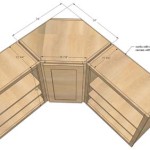Measuring Guide for Kitchen Cabinets
Installing kitchen cabinets is a significant undertaking, and accurate measurements are crucial for a successful outcome. Whether you're planning a complete kitchen renovation or simply replacing a few cabinets, precise measurements are essential for ensuring that your new cabinets fit perfectly and function effectively. This guide outlines the key steps involved in measuring for kitchen cabinets, providing a comprehensive framework for achieving accurate results.
1. Planning and Preparation
Before you begin taking measurements, it is essential to have a clear plan in mind. Determine the layout of your new kitchen, the types of cabinets you want, and the specific locations for each cabinet. Consider factors such as appliance placement, sink location, and desired counter space. Once you have a solid plan, you can proceed with measuring.
Gather the necessary tools for accurate measurements. These include a tape measure, a level, a pencil, and a notebook for recording measurements. Ensure that your tape measure is accurate and that you have a level that can be used to check for plumb and level surfaces. You may also want to have a helper on hand to assist with holding the tape measure and recording measurements.
2. Taking Measurements
Start by measuring the overall dimensions of the space where the cabinets will be installed. This includes the width, depth, and height of the area. Be sure to measure multiple points along each wall to account for any irregularities or uneven surfaces.
Next, measure the individual locations for each cabinet. Measure the width, height, and depth of each cabinet opening. Ensure that you measure the entire opening, including any trim or molding that will be attached to the cabinets.
For cabinets that will be placed against a wall, measure the distance from the wall to the center of the opening. This will help you determine the depth of the cabinets that will be ordered. For island cabinets, measure the distance from the surrounding walls to the center of the island.
Don't forget to measure the location of any appliances, sinks, or other fixtures that will be integrated into the cabinet layout. These measurements will be crucial for determining the sizes and positions of your cabinets.
3. Checking for Accuracy
Once you have taken all the necessary measurements, double-check your work for accuracy. It is important to verify that all measurements are consistent and that you have accounted for all necessary factors. If you have any doubts about your measurements, it is always best to err on the side of caution and take additional measurements.
Consider the following points when checking your measurements:
- Ensure that all measurements are taken from the same reference point.
- Check for any inconsistencies between different measurements.
- Verify that you have measured the entire opening, including any trim or molding.
- Consider any existing obstructions or uneven surfaces that may affect the cabinet installation.
4. Creating a Layout Plan
Once you have all of your measurements, you can create a detailed layout plan for your kitchen cabinets. This plan will help you visualize the final layout and ensure that your cabinets are placed in the most efficient and functional way.
The layout plan should include the following information:
- Dimensions of each cabinet opening
- Location of appliances, sinks, and other fixtures
- Desired configuration of base cabinets, wall cabinets, and island cabinets
- Desired countertop material and measurements
- Any special features or accessories that you wish to include, such as drawer dividers or pull-out shelves.
With a comprehensive layout plan in hand, you can then proceed with ordering your kitchen cabinets. It is strongly recommended to consult with a professional kitchen designer or cabinet installer to review your measurements and layout plan. They can provide valuable advice and ensure that your cabinets are properly ordered and installed for optimal functionality and aesthetics.
By following these guidelines and taking accurate measurements, you can ensure that your new kitchen cabinets fit perfectly and meet your needs. With careful planning and attention to detail, you can create a beautiful and functional kitchen space that you'll enjoy for years to come.

Measure Your Kitchen Cabinets Before Designing The Layout Cabinet Dimensions Height Measurements

How To Properly Measure For Kitchen Cabinets Cabinetmaker S Choice

Kitchen And Dining Area Measurements Standards Guide

How To Measure Kitchen Cabinets Perfectly In 7 Steps Cabinet Kings

How To Measure Your Kitchen Measuring Guide

Diy Guide How To Measure Kitchen Cabinets Like A Pro

Do It Yourself Kitchen Cabinets Installation Design Layout Kosher Cabinet
Guide To Kitchen Cabinet Sizes And Dimensions

Measurement Guide Best Stone And Kitchen

Standard Kitchen Cabinet Sizes And Dimensions Guide








